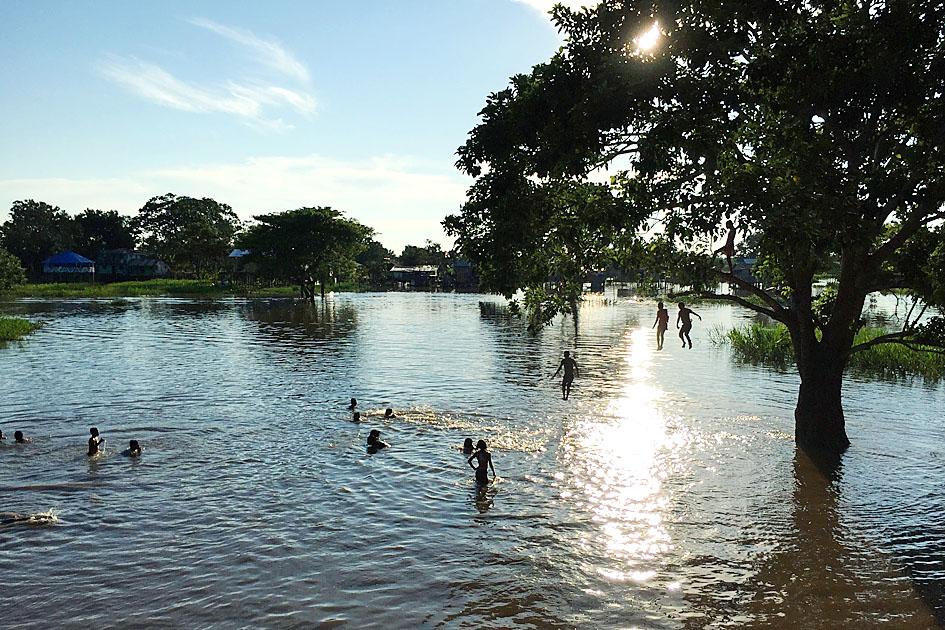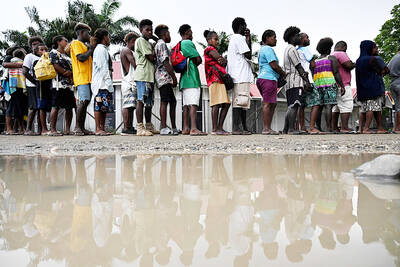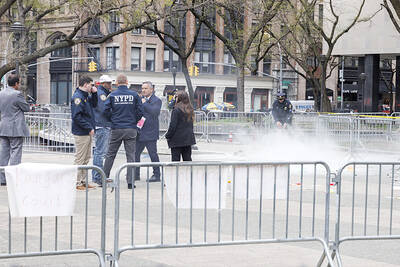Gustavo Petro, Colombia’s first elected leftist president, is to take office in August with ambitious proposals to halt the record-high rates of deforestation in the Amazon rainforest.
Petro has promised to limit agribusiness expansion into the forest, and create reserves where indigenous communities and others are allowed to harvest rubber, acai and other non-timber forest products.
He has also pledged income from carbon credits to finance replanting.

Photo: AP
“From Colombia, we will give humanity a reward, a remedy, a solution: not to burn the Amazon rainforest anymore, to recover it to its natural frontier, to give humanity the possibility of life on this planet,” Petro, wearing an indigenous headdress, said to a crowd in the Amazon city of Leticia during his campaign.
However, to do that he first needs to establish reign over large, lawless areas.
The task of stopping deforestation seems more challenging than ever. Last year, the Colombian Amazon lost 98,000 hectares of pristine forest to deforestation and another 9,000 hectares to fire. Both were down from what they had been in 2020, but last year was still the fourth worst year on record according to Monitoring of the Andean Amazon Project (MAAP), an initiative of the nonprofit Amazon Conservation Association.
TRANSITION ZONE
More than 40 percent of Colombia is in the Amazon, an area roughly the size of Spain. The country has the world’s largest bird biodiversity, mainly because it includes transition zones between the Andes mountains and the Amazon lowlands. Fifteen percent of the Colombian Amazon has already been deforested, according to Foundation for Conservation and Sustainable Development, or FCDS.
Destruction of the forest has been on the rise since 2016, the year Colombia signed a peace accord with the Revolutionary Armed Forces of Colombia (FARC) that ended decades of bloody armed conflict.
“The peace process allowed people to return to formerly conflict-ridden rural areas. As the returning population increasingly used the natural resources, it contributed to deforestation and increases in forest fires, especially in the Amazon and the Andes-Amazon transition regions,” a new paper in the journal Environmental Science and Policy said.
The presence of the state is barely felt in Colombia’s Amazon.
“Once the armed groups were demobilized, they left the forest free for cattle ranching, illegal mining and drug trafficking,” Ruth Consuelo Chaparro, director of the Roads to Identity Foundation, said in a telephone interview. “The state has not filled the gaps.”
The main driver of deforestation has been the expansion of cattle ranching. Since 2016, the number of cattle in the Amazon has doubled to 2.2 million. In the same period, about 500,000 hectares of forest were lost, according to FCDS, based on official data.
This cattle expansion goes hand in hand with illegally seized land, FCDS director Rodrigo Botero said.
“The big business deal is the land. The cows are just a way to get hold of these territories,” he told the Associated Press in a telephone interview.
Experts affirm that illegally seized lands are often resold to ranchers, who then run their cattle free of land use restrictions, such as the propriety’s size.
Most of the destruction occurs in an “arc of deforestation” in the northwestern Colombian Amazon, where even protected areas have not been spared. Chiribiquete, the world’s largest national park protecting a tropical rainforest, has lost about 6,000 hectares since 2018, according to MAAP.
DESTRUCTION
During the campaign, Botero took Petro and other presidential candidates on separate one-day trips to the Amazon. They flew over cattle ranching areas, national parks and indigenous territories.
“A very interesting thing Petro and other candidates said was that they never imagined the magnitude of the destruction,” Botero said.
The feeling of ungovernability made a deep impression on each of them, he said.
Almost 60 percent of Colombia’s greenhouse gas emissions come from agriculture, deforestation and other land use, the World Resources Institute has said.
In 2020, under the Paris Agreement, Colombian President Ivan Duque’s government committed to a 51 percent reduction in emissions by 2030. To do that, it pledged to reach net-zero deforestation by 2030.
The Amazon is the world’s largest tropical rainforest and an enormous carbon sink. There is widespread concern that its destruction would not only release massive amounts of carbon into the atmosphere, further complicating hopes of arresting climate change, but also push it past a tipping point after which much of the forest would begin an irreversible process of degradation into tropical savannah.
Although it holds almost half of the nation’s territory, the Amazon is the least populated part of Colombia, so historically it is neglected during presidential campaigns.
This year’s campaign was not a complete departure from that.
However, this year, for the first time, there was a TV presidential debate dedicated solely to environmental issues before the first round in the election. Petro, who was leading the polls then, refused to participate.
In his government program, Petro further promises to prioritize collective land titles, such as indigenous reservations and zones for landless farmers.
He also promises to control migration into the Amazon, fight illegal activities, such as land seizures, drug trafficking and money laundering via land purchases.
“Petro has studied and understands deforestation,” said Consuelo Chaparro, whose organization works with indigenous tribes in the Amazon.
However, the president alone can do nothing, she said.
Her hope is that he will listen and move things forward.
“We don’t expect him to be a Messiah,” she said.

SEEKING CHANGE: A hospital worker said she did not vote in previous elections, but ‘now I can see that maybe my vote can change the system and the country’ Voting closed yesterday across the Solomon Islands in the south Pacific nation’s first general election since the government switched diplomatic allegiance from Taiwan to Beijing and struck a secret security pact that has raised fears of the Chinese navy gaining a foothold in the region. The Solomon Islands’ closer relationship with China and a troubled domestic economy weighed on voters’ minds as they cast their ballots. As many as 420,000 registered voters had their say across 50 national seats. For the first time, the national vote also coincided with elections for eight of the 10 local governments. Esther Maeluma cast her vote in the
Nearly half of China’s major cities are suffering “moderate to severe” levels of subsidence, putting millions of people at risk of flooding, especially as sea levels rise, according to a study of nationwide satellite data released yesterday. The authors of the paper, published by the journal Science, found that 45 percent of China’s urban land was sinking faster than 3mm per year, with 16 percent at more than 10mm per year, driven not only by declining water tables, but also the sheer weight of the built environment. With China’s urban population already in excess of 900 million people, “even a small portion

UNSETTLING IMAGES: The scene took place in front of TV crews covering the Trump trial, with a CNN anchor calling it an ‘emotional and unbelievably disturbing moment’ A man who doused himself in an accelerant and set himself on fire outside the courthouse where former US president Donald Trump is on trial has died, police said yesterday. The New York City Police Department (NYPD) said the man was declared dead by staff at an area hospital. The man was in Collect Pond Park at about 1:30pm on Friday when he took out pamphlets espousing conspiracy theories, tossed them around, then doused himself in an accelerant and set himself on fire, officials and witnesses said. A large number of police officers were nearby when it happened. Some officers and bystanders rushed

HYPOCRISY? The Chinese Ministry of Foreign Affairs yesterday asked whether Biden was talking about China or the US when he used the word ‘xenophobic’ US President Joe Biden on Wednesday called for a hike in steel tariffs on China, accusing Beijing of cheating as he spoke at a campaign event in Pennsylvania. Biden accused China of xenophobia, too, in a speech to union members in Pittsburgh. “They’re not competing, they’re cheating. They’re cheating and we’ve seen the damage here in America,” Biden said. Chinese steel companies “don’t need to worry about making a profit because the Chinese government is subsidizing them so heavily,” he said. Biden said he had called for the US Trade Representative to triple the tariff rates for Chinese steel and aluminum if Beijing was